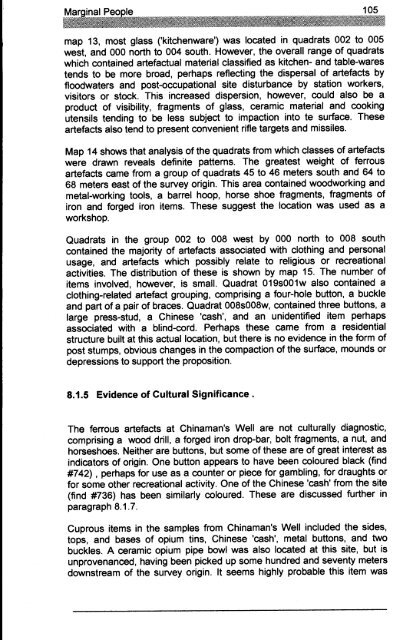Adec Preview Generated PDF File - The Sydney eScholarship ...
Adec Preview Generated PDF File - The Sydney eScholarship ...
Adec Preview Generated PDF File - The Sydney eScholarship ...
Create successful ePaper yourself
Turn your PDF publications into a flip-book with our unique Google optimized e-Paper software.
map 13, most glass ('kitchenware') was located in quadrats 002 to 005<br />
west, and 000 north to 004 south. However, the overall range of quadrats<br />
which contained artefactual material classified as kitchen- and table-wares<br />
tends to be more broad, perhaps reflecting the dispersal of artefacts by<br />
f100dwaters and post-occupational site disturbance by station workers,<br />
visitors or stock. This increased dispersion, however, could also be a<br />
product of visibility, fragments of glass, ceramic material and cooking<br />
utensils tending to be less subject to impaction into te surface. <strong>The</strong>se<br />
artefacts also tend to present convenient rifle targets and missiles.<br />
Map 14 shows that analysis of the quadrats from which classes of artefacts<br />
were drawn reveals definite patterns. <strong>The</strong> greatest weight of ferrous<br />
artefacts came from a group of quadrats 45 to 46 meters south and 64 to<br />
68 meters east of the survey origin. This area contained woodworking and<br />
metal-working tools, a barrel hoop, horse shoe fragments, fragments of<br />
iron and forged iron items. <strong>The</strong>se suggest the location was used as a<br />
workshop.<br />
Quadrats in the group 002 to 008 west by 000 north to 008 south<br />
contained the majority of artefacts associated with clothing and personal<br />
usage, and artefacts which possibly relate to religious or recreational<br />
activities. <strong>The</strong> distribution of these is shown by map 15. <strong>The</strong> number of<br />
items involved, however, is small. Quadrat 019s001w also contained a<br />
clothing-related artefact grouping, comprising a four-hole button, a buckle<br />
and part of a pair of braces. Quadrat 008s008w, contained three buttons, a<br />
large press-stud, a Chinese 'cash', and an unidentified item perhaps<br />
associated with a blind-cord. Perhaps these came from a residential<br />
structure built at this actual location, but there is no evidence in the form of<br />
post stumps, obvious changes in the compaction of the surface, mounds or<br />
depressions to support the proposition.<br />
8.1.5 Evidence of Cultural Significance.<br />
<strong>The</strong> ferrous artefacts at Chinaman's Well are not culturally diagnostic,<br />
comprising a wood drill, a forged iron drop-bar, bolt fragments, a nut, and<br />
horseshoes. Neither are buttons, but some of these are of great interest as<br />
indicators of origin. One button appears to have been coloured black (find<br />
#742) , perhaps for use as a counter or piece for gambling, for draughts or<br />
for some other recreational activity. One of the Chinese 'cash' from the site<br />
(find #736) has been similarly coloured. <strong>The</strong>se are discussed further in<br />
paragraph 8.1.7.<br />
Cuprous items in the samples from Chinaman's Well included the sides,<br />
tops, and bases of opium tins, Chinese 'cash', metal buttons, and two<br />
buckles. A ceramic opium pipe bowl was also located at this site, but is<br />
unprovenanced, having been picked up some hundred and seventy meters<br />
downstream of the survey origin. It seems highly probable this item was




